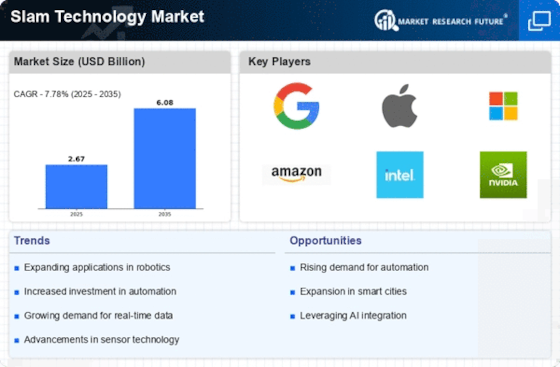Advancements in Augmented Reality
Advancements in augmented reality (AR) are emerging as a significant driver for the Slam Technology Market. The integration of Slam technology in AR applications facilitates real-time interaction between digital content and the physical environment. As the AR market is projected to reach USD 198 billion by 2025, the demand for accurate and efficient Slam solutions is likely to increase. This technology enables devices to understand their surroundings, providing users with immersive experiences that blend the virtual and real worlds. Consequently, the growth of AR applications in gaming, education, and training sectors is expected to stimulate the Slam Technology Market, as developers seek to enhance user engagement through innovative solutions. The synergy between AR and Slam technology presents a promising avenue for future developments in interactive applications.
Expansion of Robotics Applications
The expansion of robotics applications across various sectors is significantly influencing the Slam Technology Market. Industries such as manufacturing, healthcare, and agriculture are increasingly adopting robotic solutions that require advanced navigation capabilities. For instance, The Slam Technology is expected to grow to USD 210 billion by 2025, with a substantial portion attributed to the integration of Slam technology. This technology enables robots to navigate complex environments autonomously, enhancing their functionality and efficiency. As organizations seek to automate processes and improve productivity, the demand for sophisticated Slam solutions is likely to rise, thereby propelling growth within the Slam Technology Market. The versatility of Slam technology in diverse robotic applications underscores its importance in driving innovation and operational excellence.
Increased Investment in Smart Cities
The increased investment in smart city initiatives is driving the Slam Technology Market forward. As urban areas seek to enhance infrastructure and improve quality of life, the implementation of smart technologies becomes essential. Slam technology is integral to various smart city applications, including autonomous public transport, traffic management, and urban planning. Recent reports indicate that investments in smart city projects are expected to exceed USD 2 trillion by 2025, highlighting the potential for growth in the Slam Technology Market. The ability of Slam solutions to provide accurate spatial data and real-time analytics is crucial for the successful deployment of smart city initiatives. As cities evolve into smarter environments, the demand for innovative Slam technologies is likely to rise, fostering advancements in urban development and sustainability.
Rising Demand for Autonomous Vehicles
The increasing demand for autonomous vehicles is a pivotal driver in the Slam Technology Market. As manufacturers strive to enhance vehicle navigation and safety, Slam technology plays a crucial role in enabling real-time mapping and localization. According to recent data, the autonomous vehicle market is projected to reach USD 557 billion by 2026, indicating a substantial growth trajectory. This surge in demand necessitates advanced Slam solutions to ensure precise navigation and obstacle detection, thereby fostering innovation within the Slam Technology Market. Furthermore, the integration of Slam technology in autonomous systems not only enhances operational efficiency but also contributes to the overall safety of transportation systems, making it a vital component in the evolution of modern mobility solutions.
Growing Need for Enhanced Security Solutions
The growing need for enhanced security solutions is a critical driver in the Slam Technology Market. As security concerns escalate across various sectors, the demand for advanced surveillance and monitoring systems is increasing. Slam technology offers innovative solutions for real-time tracking and mapping, which are essential for effective security applications. The Slam Technology is projected to reach USD 300 billion by 2025, with a significant portion attributed to the integration of Slam technology in security systems. This technology enables the development of autonomous drones and robots capable of navigating complex environments for surveillance purposes. As organizations prioritize safety and security, the adoption of Slam solutions is likely to expand, thereby propelling growth within the Slam Technology Market. The intersection of security needs and technological advancements presents a promising landscape for future developments.


















Leave a Comment